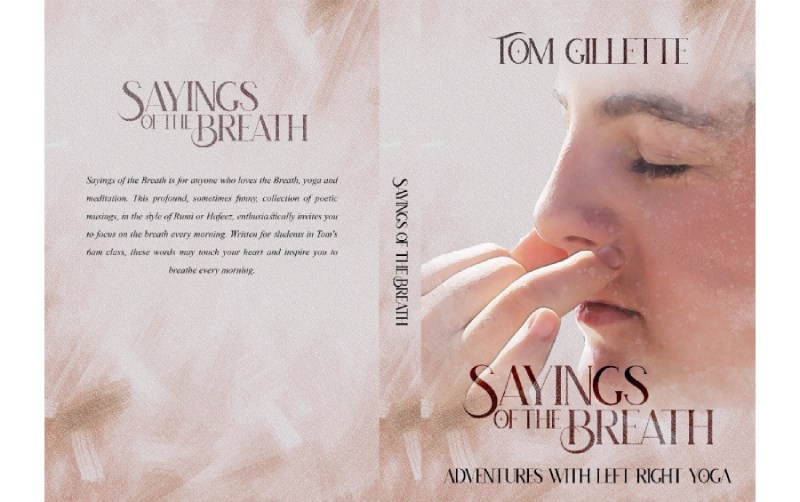A Paradigm Shift of Pranayama and Poems about the Breath

A paradigm shift is happening in the yoga world. The breath practices of Classical Yoga called “pranayama,” have been around for 2000 years without much change, until now. Modern yogis practice 1 to
2 hours of postures, called “asana,” but only a couple minutes of pranayama, intentional breath practices.
Most yoga teachers praise a 15 minute practice of yoga postures as a good start, but you don’t really know yoga, until you practice an hour or two of postures. Tom Gillette, a yoga teacher of 35 years, asked “why is it modern yogis only practice pranayama a for few minutes?”
The most important breath technique, according to many well known gurus, is called alternate nostril breath. It is a beginner practice. You close off one nostril, inhale through the open nostril and then alternate the sinuses before each exhale. The practice has profound long term physiological effects when sustained for long periods of time and practiced everyday. Can this practice be done for hours, like asana practice?
Traditional instructions ask students to sit on the floor, and use one hand to alternate the nostrils. The shoulder and arm are frozen in position. This awkward, asymmetrical position gets very uncomfortable in a few minutes. After 10 or 15 minutes, it creates a pain in the neck, back and shoulders. It is hard to fall in love with a practice that hurts everyday.
“And that is why no one really practices this pranayama for hours,” claims Mr Gillette, who practices pranayama one to two hours a day and has so for many years. He calls sitting on the floor and floating your arm “Inaccessible Pranayama.” A few years ago, he asked the question, “How can we redesign the practice and find a form that everyone can
can really go deep with? How can we discover a form of “Accessible Pranayama? Is there a way for everyone to explore and develop the full power of the pranayama without the pain and suffering?”
Sayings of the Breath is one part yoga manual, and one part collection of delightful breath poetry. As Tom Gillette meditated on the alternating breath in the early morning hours before the sunrise, his mind became really quiet and clear. Words started to come from the air. He began writing about his breath experiments, breath experiences and breath discoveries in poetic form for his students.
The poetry dives deep into the big questions of life, what’s our purpose, what do we value and the curious intersection between life, breath and death. The verse is sometimes profoundly funny, with clever turns of phrases and insights into the practice itself. You will delight in picking this book up and reading a page day. Yoga teachers will love this book for the rich collection of inspired readings for the end of a yoga class.
In order for the “prana,” the life force, to build up and become strong enough, 7 days a week practice is essential. The most important dimension of alternate nostril breath is to develop a daily habit of everyday practice and not miss a day. If you miss days, the life force, “prana” never builds up sufficiently. Swami Sivananada said it takes an established Hatha Yogi a minimum of 24 minutes of Alternate Nostril
Breath every day for a year for the astounding long term effects to begin to work.
Modern scientific research is starting to uncover the possible mechanisms usuggesting why this practice works. It has been shown that a short lived gas called Nitric Oxide (NO), not to be confused with Nitrous Oxide (N20) laughing gas, is slowly released from the paranasal sinuses with alternate nostril practice. Nitric Oxide begins by killing all the bacteria, viruses, mold and organisms that may be floating in the sinuses, before it gets into your lungs. When Nitric Oxide is released, the cleaned air descends in to the lungs, and then the Nitric Oxide dilates the bronchial tissues increasing lung volume. Nitric Oxide then dilates the blood vessels which lowers systolic blood pressure, meaning the heart doesn’t have to pump so hard to achieve the same result.
Another dimension of Alternate Nostril Breath is that as the air passes through one sinus, it stimulates the nerve endings in that sinus. The nerve endings in the nose stimulate the opposing somatosensory regions of the left and right cerebral hemispheres. As the breath goes back and forth, it sets up a rhythm of alternating cerebral hemisphere stimulation, kind of like “brain massage,” quips Mr Gillette. The long term effects of a significant Alternate Nostril Breath practice has been difficult for modern research to study, because studies have focused only on short lived, 10 minute practices using traditional instructions.
However, Tom Gillette and his 2 dozen strong band of online breathers have been doing a 24 minute practice together for over 3 years! On Sundays and special Wednesdays, they practice for 48 minutes, without pain or strain or difficulty! What are they doing? Find out how they do this easily and without strain. Even more astounding is that Mr Gillette teaches in the traditional way of India, by donation!
“The value of this practice has not been fully realized because there are very few yogis who do massive amounts of practice everyday to tell others about it. And now we have many ordinary people who are passing significant milestones with alternate nostril breath, intentionally beginning each day with gratitude, increasing lung volume, lowering blood pressure, slowing down the breath to deep levels of meditation and so many other miracles are occurring,” concludes Mr Gillette.
This small little book, Sayings of the Breath by Tom Gillette, picks up where the best selling book “Breath” by James Nestor left off. Sayings of the Breath offers a paradigm shift in the way pranayama has been taught, while the quirky and poignant poetry may touch your heart, delight your mind and help you to stay inspired with your practice everyday.